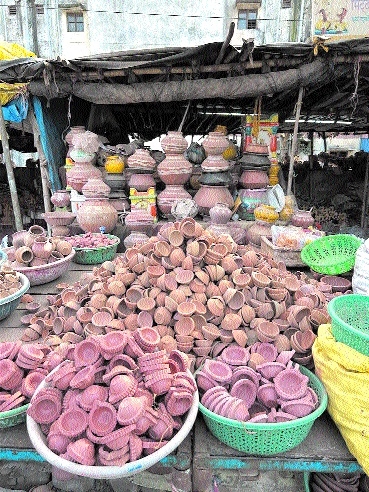Market witnesses surge in sale of earthen lamps this Diwali
29 Oct 2024 14:48:42

By Aditya Akash :
The festival of Diwali is set to begin and will be celebrated with great enthusiasm across the country. The City of Lakes is no exception. The streets are filled with the glow of lamps, the sound of fireworks, and the joyous spirit of the festival. During this festive season, there is a noticeable surge in the demand for various types of decorative lamps, particularly special ones sourced from Kolkata and other major cities.
In local markets, items such as turtle-shaped lamps and elephant-shaped lamps are flying off the shelves, indicating a booming business for shopkeepers. Vishnu Prajapati, who operates his business near MANIT square, shared insights about the current market trends. He emphasised, “This year, there is a significantly higher demand for lamps compared to previous years”. Despite this increase in demand, he has chosen not to raise the prices of his lamps.
He explained that while the cost of transporting the clay he uses has gone up, he remains committed to keeping his prices stable. Last year, he had around 1,000 to 1,200 lamps left unsold after the festival, but this year he anticipates selling over 2,000 highlighting a shift in consumer interest. The marketplace around Manit Square hosts about 10 to 12 shops dedicated to selling earthen lamps (Diyas) and idols, all experiencing similar trends of increased demand. In addition to lamps, the supply of idols made by local artisans has also seen a significant rise. The prices of these idols range from Rs 120 to Rs 500, with particularly popular figures being Goddess Lakshmi and Lord Ganesha. Prajapati noted that during the Diwali season, sales for these idols reach between 1,000 to 2,000 units, making it a lucrative time for artisans and shopkeepers alike.
“When it comes to diyas, prices start as low as Rs 2 and can go up to Rs 5 for standard varieties. More elaborate, colourful lamps, which vary in price based on their size and design, see higher price points. For instance, the turtle-shaped and elephant-shaped diya can sell for between Rs 50 to Rs 200. Prajapati also pointed out that the clay used to make these idols is sourced from outside the region, and the costs of other materials have risen as well. This has led to an interesting dynamic that if he produces more idols, he faces higher costs, but producing fewer can also impact pricing strategies. Shopkeepers explained that their business typically operates on a seasonal basis, earning during the six months leading up to Diwali and then having to manage for the next six months with little to no income. Despite the challenges, they remain optimistic, especially during this festive season.
Beyond the economic aspects, there is a deeper cultural significance to lighting diya during Diwali.
These diyas symbolise goodness, purity, and the dispelling of darkness. The act of lighting a lamp is not just a decorative choice; it is a profound gesture that represents the triumph of light over darkness, knowledge over ignorance, and good over evil. It is a reminder that even in the darkest times, there is always a path towards light and hope.
Significantly, Diwali in Bhopal is not just a festival; it is a vibrant display of culture, tradition, and commerce. The city’s markets are alive with activity, reflecting both the spirit of the festival and the resilience of the local economy. As citizens celebrate, they are also part of a larger narrative about community, sustainability, and the enduring power of hope and light.